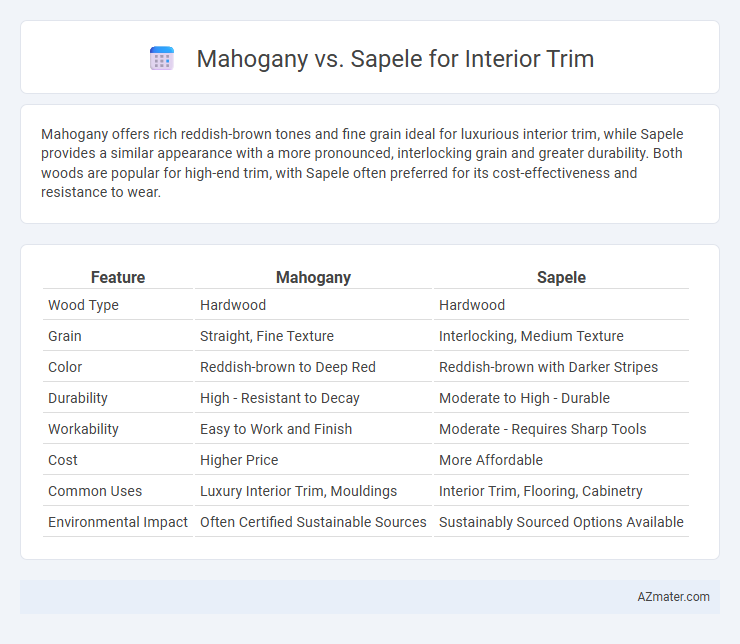Mahogany offers rich reddish-brown tones and fine grain ideal for luxurious interior trim, while Sapele provides a similar appearance with a more pronounced, interlocking grain and greater durability. Both woods are popular for high-end trim, with Sapele often preferred for its cost-effectiveness and resistance to wear.
Table of Comparison
| Feature | Mahogany | Sapele |
|---|---|---|
| Wood Type | Hardwood | Hardwood |
| Grain | Straight, Fine Texture | Interlocking, Medium Texture |
| Color | Reddish-brown to Deep Red | Reddish-brown with Darker Stripes |
| Durability | High - Resistant to Decay | Moderate to High - Durable |
| Workability | Easy to Work and Finish | Moderate - Requires Sharp Tools |
| Cost | Higher Price | More Affordable |
| Common Uses | Luxury Interior Trim, Mouldings | Interior Trim, Flooring, Cabinetry |
| Environmental Impact | Often Certified Sustainable Sources | Sustainably Sourced Options Available |
Introduction: Comparing Mahogany and Sapele for Interior Trim
Mahogany and Sapele are premium hardwoods renowned for their durability and rich, warm tones, making them popular choices for interior trim. Mahogany offers a deep reddish-brown color with a smooth, straight grain ideal for elegant finishes, while Sapele exhibits a vibrant, golden to reddish-brown hue with interlocking grain patterns that create a subtle shimmer. Both woods provide excellent workability and resistance to wear, but Mahogany is often preferred for its classic luxury appeal, whereas Sapele is sought after for its unique aesthetic and cost-effectiveness.
Origin and Availability of Mahogany and Sapele
Mahogany, primarily sourced from Central America and West Africa, is renowned for its rich, reddish-brown hue and consistent grain, making it a premium choice for interior trim. Sapele, native to tropical Africa, offers a similar appearance with a slightly more pronounced grain and a warmer tone, providing a cost-effective alternative that remains widely available. Both woods are sustainably harvested in some regions but Mahogany's limited supply often leads to higher prices compared to the more abundant Sapele.
Color and Grain Differences
Mahogany features a warm reddish-brown hue with a fine, straight grain that offers a smooth, uniform appearance ideal for classic interior trim. Sapele exhibits a more varied golden to reddish-brown color palette with interlocking grain patterns that create a ribbon-like, textured effect, adding visual interest and depth. Choosing between mahogany and sapele depends on the desired balance between consistent coloration and intricate grain detail in interior woodwork.
Durability and Hardness Comparison
Mahogany and Sapele are both prized hardwoods for interior trim, known for their durability and aesthetic appeal. Mahogany boasts a Janka hardness rating of approximately 800-900, offering excellent resistance to dents and wear, while Sapele rates slightly higher around 1,410, making it harder and more resistant to scratches. This increased hardness of Sapele enhances its longevity in high-traffic areas, though both woods maintain impressive stability and durability for interior applications.
Workability and Ease of Installation
Mahogany offers superior workability due to its fine grain and smooth texture, making it easier to cut, shape, and sand for intricate interior trim designs. Sapele, while slightly harder and denser, still provides good machinability but may require sharper tools and more effort during installation. Both hardwoods are durable, yet mahogany's consistency in texture makes it a preferred choice for craftsmen seeking streamlined installation and detailed finish work in interior trim projects.
Finishing Qualities and Aesthetic Appeal
Mahogany offers a rich, deep reddish-brown color with a fine, straight grain that enhances interior trim with a luxurious, classic finish, known for excellent stain absorption and smooth polishability. Sapele exhibits a striking interlocked grain pattern and a warm reddish-brown hue that darkens over time, providing a dramatic visual texture and a high-gloss finish ideal for sophisticated interior accents. Both woods deliver durability and elegance, but Mahogany's consistent grain and superior finishing qualities make it preferable for seamless, refined trim work.
Cost Analysis: Mahogany vs Sapele
Mahogany typically commands a higher price than Sapele due to its greater rarity and more desirable grain patterns, with costs ranging from $15 to $30 per board foot compared to Sapele's $8 to $15 per board foot. Sapele presents a cost-effective alternative for interior trim, offering similar durability and a rich reddish-brown hue, making it suitable for budget-conscious projects without compromising aesthetics. When analyzing long-term value, Mahogany's superior workability and finish quality may justify the initial higher investment for luxury interiors.
Suitability for Different Interior Styles
Mahogany offers rich, reddish-brown tones and fine grain that complement traditional, classic, and Victorian interior styles, enhancing elegance and warmth. Sapele, with its darker, more pronounced grain and reddish-brown to deep brown hues, suits contemporary, modern, and eclectic interiors, providing a bold yet versatile look. Both woods are durable and work well for interior trim, but selection depends on the desired aesthetic impact and style coherence.
Maintenance and Longevity
Mahogany offers exceptional durability and resists wear, making it a preferred choice for interior trim that requires minimal maintenance over time. Sapele, while also durable, is slightly less resistant to dents and scratches, necessitating occasional refinishing to maintain its appearance. Both woods provide excellent longevity, but mahogany's tighter grain structure enhances its ability to withstand daily use in high-traffic interior environments.
Which Wood to Choose for Your Interior Trim?
Mahogany offers a rich, reddish-brown hue and fine grain ideal for luxurious interior trim, providing durability and resistance to rot and insect damage. Sapele features a more pronounced grain pattern with a warm, golden-brown color that darkens over time, making it a cost-effective alternative with comparable hardness and stability. Choosing between mahogany and sapele depends on budget preferences, desired aesthetic, and the level of maintenance you expect for your interior wood trim.

Infographic: Mahogany vs Sapele for Interior Trim
 azmater.com
azmater.com